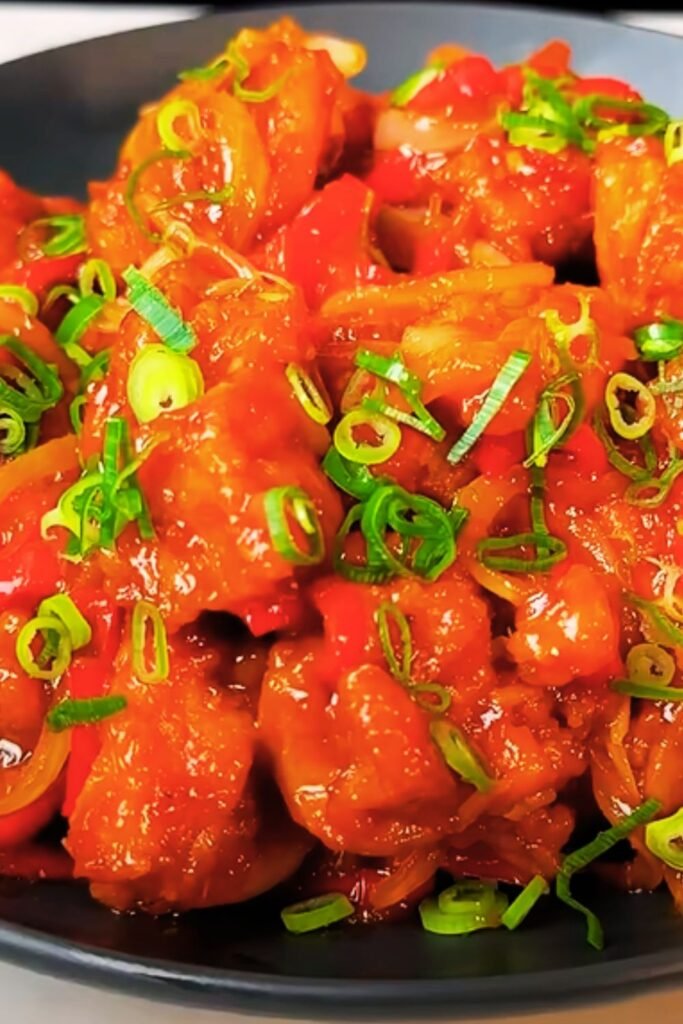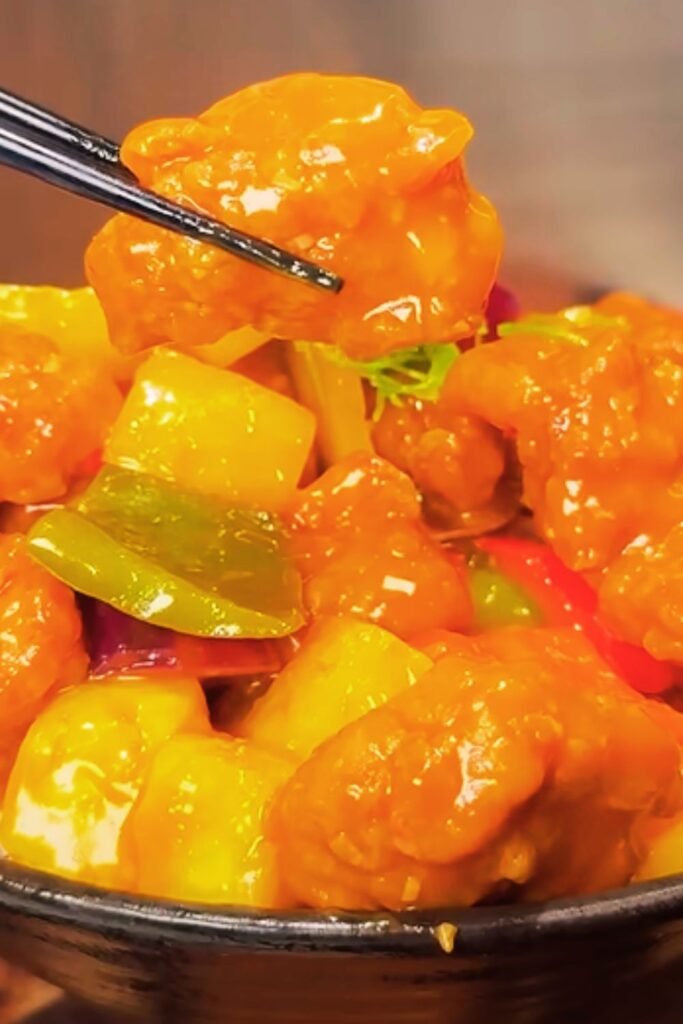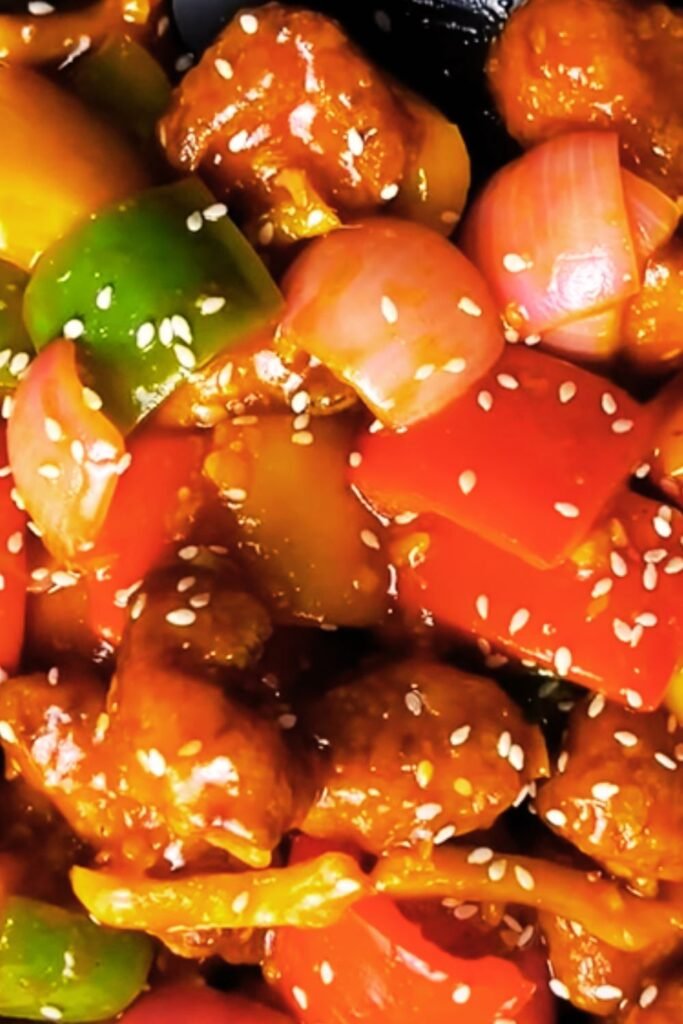Have you ever craved that perfect combination of tangy sweetness and savory goodness that makes your taste buds dance? I’m talking about that magical balance found in a well-made sweet and sour chicken stir fry. This iconic dish has been a staple in my kitchen for years, and today I’m excited to share not just my tried-and-true recipe, but all the tips and tricks I’ve learned along the way to make this dish absolutely sing.
Sweet and sour chicken represents the beautiful harmony that can exist between opposing flavors. The sweetness, typically derived from fruits and sugar, perfectly counters the sourness from vinegar and citrus elements. When these flavors dance together with tender chicken pieces and crisp vegetables, the result is nothing short of culinary poetry.
What I love most about this dish is its versatility. Whether you’re cooking for picky eaters or adventurous food enthusiasts, sweet and sour chicken stir fry has a way of pleasing everyone at the table. The vibrant colors also make it a feast for the eyes, proving that we truly do eat with our eyes first!
The History Behind Sweet and Sour
Before diving into our recipe, I think it’s worth taking a moment to appreciate where this delicious flavor combination originated. Sweet and sour dishes have been part of Chinese cuisine for centuries, with the earliest recorded sweet and sour recipes dating back to the 18th century in the Hunan province.
What we know today as sweet and sour chicken in Western cuisine is an adaptation that evolved as Chinese food spread globally. The original versions were typically made with fish or pork, and the bright red sauce we’re familiar with today is actually a Western evolution of the dish.
In traditional Chinese cooking, the sweet and sour flavor profile is more subtle, often achieved through a careful balance of vinegar, sugar, and soy sauce. The vibrant red color we associate with sweet and sour dishes in Western restaurants typically comes from tomato paste or ketchup—ingredients that were incorporated as the dish adapted to Western palates.
I find it fascinating how recipes evolve as they travel across cultures, each adding their own twist while maintaining the essence of what makes the dish special. This cross-cultural evolution has given us the beloved sweet and sour chicken that graces tables worldwide today.
Essential Ingredients: Building Blocks of Flavor
The beauty of sweet and sour chicken lies in its relatively simple ingredient list that creates complex flavors. Let’s break down the key components:
For the Chicken:
- Chicken breast or thighs: I personally prefer thighs for their juiciness and flavor, but breasts work beautifully too if you’re looking for a leaner option.
- Cornstarch: This creates that signature light, crispy coating on the chicken pieces.
- Egg white: Helps the cornstarch adhere to the chicken while adding tenderness.
- Salt and pepper: The fundamental seasoning duo that enhances the chicken’s natural flavor.
For the Sweet and Sour Sauce:
- Rice vinegar: Provides the sour element with a milder, more rounded acidity than white vinegar.
- Brown sugar: Offers a deeper sweetness with molasses notes that plain sugar lacks.
- Ketchup: Adds both tomato flavor and color to the sauce.
- Pineapple juice: Brings natural sweetness and tropical notes.
- Soy sauce: Provides umami depth and saltiness.
- Garlic and ginger: The aromatic foundation that gives the sauce dimension.
- Red pepper flakes: Optional for those who enjoy a hint of heat.
For the Stir Fry:
- Bell peppers: Traditionally red and green for color contrast, but any color works.
- Onion: Adds sweetness when cooked and sharpness when barely cooked.
- Pineapple chunks: Fresh is best, but canned works well too.
- Scallions: For a fresh, mild onion flavor as garnish.
- Sesame seeds: Add a nutty finish and visual appeal.

The Equipment You’ll Need
Before we start cooking, let’s make sure you have the right tools for the job:
- Wok or large skillet: The wide surface area and high sides make it perfect for stir-frying.
- Sharp knife: For clean cuts on your chicken and vegetables.
- Mixing bowls: For marinating chicken and preparing sauce.
- Wooden spoon or spatula: For stirring without scratching your cookware.
- Measuring cups and spoons: For precise ingredient amounts.
- Whisk: To thoroughly combine sauce ingredients.
- Paper towels: For draining excess oil from fried chicken.
Not having a wok shouldn’t stop you—a large skillet works perfectly well. The key is having enough surface area for ingredients to cook quickly without steaming.
Detailed Recipe: Step-by-Step Guidance
Now that we understand our ingredients and have our equipment ready, let’s dive into the cooking process. I’ll guide you through each step to ensure your sweet and sour chicken stir fry turns out perfectly every time.
Sweet and Sour Chicken Stir Fry Recipe
Prep Time: 25 minutes
Cook Time: 20 minutes
Total Time: 45 minutes
Servings: 4
Marinating the Chicken:
- Cut 1.5 pounds of boneless, skinless chicken (breast or thigh) into 1-inch cubes.
- In a medium bowl, whisk together:
- 1 egg white
- 1 tablespoon soy sauce
- 1 teaspoon salt
- ¼ teaspoon white pepper
- Add chicken pieces and marinate for at least 15 minutes (or up to 2 hours in the refrigerator).
- After marinating, drain excess liquid and toss chicken in ½ cup cornstarch until each piece is lightly coated.
Preparing the Sweet and Sour Sauce:
In a bowl, whisk together:
- ⅓ cup rice vinegar
- ½ cup brown sugar
- 3 tablespoons ketchup
- 2 tablespoons pineapple juice
- 1 tablespoon soy sauce
- 1 teaspoon minced garlic
- 1 teaspoon minced ginger
- ¼ teaspoon red pepper flakes (optional)
- 1 tablespoon cornstarch dissolved in 2 tablespoons water
Cooking the Dish:
- Heat 2 inches of vegetable oil in your wok or deep skillet to 350°F (175°C).
- Working in batches, fry the coated chicken pieces until golden brown and cooked through, about 3-4 minutes. Don’t overcrowd the pan.
- Transfer fried chicken to a paper towel-lined plate to drain excess oil.
- Pour out all but 1 tablespoon of oil from the wok.
- Over medium-high heat, stir-fry:
- 1 onion, cut into chunks
- 1 red bell pepper, cut into 1-inch pieces
- 1 green bell pepper, cut into 1-inch pieces
- Cook for 2-3 minutes until vegetables begin to soften but remain crisp.
- Add 1 cup fresh or canned pineapple chunks and stir-fry for another minute.
- Pour in the sweet and sour sauce mixture and bring to a simmer.
- Once the sauce begins to thicken (about 1-2 minutes), add the fried chicken pieces back to the wok.
- Toss everything together until the chicken and vegetables are well-coated with the sauce.
- Garnish with sliced scallions and sesame seeds before serving.

The Science Behind Perfect Sweet and Sour Chicken
Have you ever wondered why restaurant sweet and sour chicken has that perfect texture—crispy on the outside, juicy on the inside, and somehow stays crisp even when coated in sauce? Let me share some culinary science that explains these techniques:
Velveting the Chicken
The egg white in the marinade is part of a Chinese cooking technique called “velveting.” The protein in egg white forms a protective coating around each piece of chicken, locking in moisture during cooking. This results in incredibly tender meat, even when subjected to high-heat stir-frying or deep-frying.
The Cornstarch Coating
Cornstarch serves multiple purposes in this recipe:
- It creates a light, crispy exterior on the chicken when fried
- It helps thicken the sauce to the perfect consistency
- It forms a barrier that prevents the chicken from becoming soggy when mixed with the sauce
The Balance of Flavors
The perfect sweet and sour sauce is all about balance. Here’s how each component contributes:
- Sugar: Activates sweet receptors on your tongue
- Vinegar: Activates sour receptors and brightens all flavors
- Salt (from soy sauce): Enhances other flavors and balances sweetness
- Umami (from ketchup and soy sauce): Adds depth and satisfaction
- Heat (from ginger, garlic, and optional chili): Provides warmth and complexity
This balance is why sweet and sour dishes are so satisfying—they hit nearly all your taste receptors simultaneously!
Nutritional Information: Know What You’re Eating
Understanding the nutritional profile of your meal can help you make informed choices about portion sizes and accompaniments. Here’s a breakdown of the approximate nutritional content per serving of sweet and sour chicken stir fry:
| Nutrient | Amount per Serving | % Daily Value* |
|---|---|---|
| Calories | 385 | – |
| Total Fat | 12g | 15% |
| Saturated Fat | 2g | 10% |
| Cholesterol | 85mg | 28% |
| Sodium | 890mg | 39% |
| Carbohydrates | 42g | 15% |
| Dietary Fiber | 3g | 11% |
| Sugars | 28g | – |
| Protein | 28g | 56% |
| Vitamin A | – | 35% |
| Vitamin C | – | 120% |
| Calcium | – | 6% |
| Iron | – | 15% |
*Based on a 2,000 calorie diet
This dish is relatively high in protein and offers a good amount of vitamins from the vegetables. The sugar content is notable, coming primarily from the sweet and sour sauce. If you’re watching your sugar intake, you might consider reducing the amount of brown sugar or using a substitute.
Variations: Make It Your Own
One of the joys of cooking is adapting recipes to suit your taste and dietary needs. Here are some delicious variations on the classic sweet and sour chicken:
Protein Alternatives:
- Sweet and Sour Tofu: Replace chicken with extra-firm tofu, pressed and cubed. This makes a wonderful vegetarian version.
- Sweet and Sour Shrimp: Swap chicken for peeled and deveined shrimp for a seafood twist.
- Sweet and Sour Pork: Use pork tenderloin cut into 1-inch pieces for a traditional Chinese restaurant version.
Dietary Adaptations:
- Gluten-Free: Use tamari instead of soy sauce and ensure your vinegar is gluten-free.
- Lower Sugar: Reduce brown sugar by half and add a drop of stevia, or use a brown sugar substitute.
- Paleo-Friendly: Replace soy sauce with coconut aminos and use honey instead of brown sugar.
Flavor Twists:
- Spicy Sweet and Sour: Add 1-2 tablespoons of chili garlic sauce or sriracha to the sweet and sour sauce.
- Orange Sweet and Sour: Replace half the pineapple juice with orange juice and add 1 teaspoon of orange zest.
- Honey Ginger: Use honey instead of brown sugar and double the amount of fresh ginger.

Common Mistakes to Avoid
Even experienced cooks can run into issues when making sweet and sour chicken. Here are some pitfalls to avoid:
- Overcrowding the pan when frying: This lowers the oil temperature and results in soggy rather than crispy chicken. Work in batches instead.
- Adding sauce too early: Vegetables should be stir-fried first to maintain their crispness. Add sauce only after vegetables have reached desired tenderness.
- Not preparing all ingredients in advance: Stir-frying moves quickly—have everything chopped and sauces mixed before you start cooking.
- Using cold chicken straight from the refrigerator: Cold meat doesn’t cook evenly. Let marinated chicken sit at room temperature for 15-20 minutes before cooking.
- Cutting vegetables in inconsistent sizes: Ensure all pieces are similar in size for even cooking.
- Not tasting and adjusting the sauce: Everyone’s preference for sweet and sour balance differs, so taste and adjust before adding to your stir-fry.
- Using low heat for stir-frying: Stir-frying requires high heat to properly sear ingredients while keeping them crisp-tender.
Serving Suggestions: Creating a Complete Meal
Sweet and sour chicken stir fry is versatile enough to be served in multiple ways. Here are my favorite serving options:
Classic Pairings:
- Steamed Jasmine Rice: The perfect canvas to soak up the delicious sauce.
- Fried Rice: For a more substantial meal, especially good with leftover rice.
- Noodles: Try thin egg noodles or rice noodles tossed with a bit of sesame oil.
Side Dish Ideas:
- Vegetable Spring Rolls: The crispy texture complements the saucy stir fry.
- Hot and Sour Soup: A traditional pairing in Chinese restaurants.
- Cucumber Salad: A cool, crisp side that balances the sweet main dish.
- Steamed Broccoli: For extra vegetables and nutrition.
Presentation Tips:
- Serve family-style in a large bowl with serving utensils.
- For individual plating, create a bed of rice, place sweet and sour chicken on top, and garnish with extra scallions and sesame seeds.
- Consider a sprinkle of thinly sliced fresh chili for color and heat.
- A wedge of lime on the side adds a fresh touch and lets diners adjust acidity to taste.
Storage and Leftovers: Making the Most of Your Meal
Sweet and sour chicken stir fry makes excellent leftovers, but proper storage is key to maintaining quality:
Storage Guidelines:
- Refrigeration: Store in an airtight container for up to 3 days.
- Freezing: While possible, the texture of the vegetables and coating on the chicken will suffer. If freezing, store for no more than 1 month.
- Separation: For best results, store chicken and sauce separately from rice or noodles.
Reheating Tips:
- Stovetop Method: For best texture, reheat in a wok or skillet over medium heat until just hot. Add a splash of water if the sauce has thickened too much.
- Microwave Method: Use 70% power and stir halfway through to ensure even heating.
- Oven Method: Place in an oven-safe dish, cover with foil, and heat at 325°F (165°C) for about 15 minutes or until heated through.
Creative Uses for Leftovers:
- Sweet and Sour Chicken Wrap: Roll leftover sweet and sour chicken in a flour tortilla with some fresh lettuce and extra sauce.
- Asian-Inspired Rice Bowl: Top freshly cooked rice with reheated sweet and sour chicken and add fresh ingredients like avocado slices and a fried egg.
- Sweet and Sour Chicken Salad: Serve cold leftover chicken over crisp greens with a sesame dressing.
Frequently Asked Questions
Q: Can I make this dish ahead of time for a party? A: Yes, but I recommend preparing the components separately. Fry the chicken and make the sauce up to a day ahead, then reheat the chicken in a 350°F oven until crisp (about 10 minutes) and warm the sauce separately. Stir-fry the vegetables fresh, then combine all components just before serving.
Q: How can I make this healthier? A: Instead of deep-frying, you can air-fry the chicken pieces at 380°F for about 10-12 minutes, or bake them at 425°F for 15-18 minutes. You can also reduce the sugar in the sauce by half and add more vegetables to the stir-fry.
Q: My sauce isn’t thickening properly. What went wrong? A: Make sure your cornstarch slurry (cornstarch mixed with cold water) is well mixed before adding to the sauce. Also, the sauce needs to come to a simmer after adding the slurry to activate the thickening properties of cornstarch.
Q: Can I use frozen vegetables for this recipe? A: Fresh vegetables provide the best texture, but in a pinch, frozen bell peppers and onions can work. Thaw completely and pat dry before stir-frying, and reduce the stir-fry time as they’re already partially cooked.
Q: How do I prevent the chicken from becoming soggy when mixed with the sauce? A: Ensure your chicken is well-drained after frying and that the sauce has thickened properly before combining. Also, mix the chicken with the sauce just before serving rather than letting it sit.
Q: Is sweet and sour chicken actually authentic Chinese cuisine? A: The sweet and sour flavor profile is authentic to Chinese cuisine, particularly Cantonese cooking. However, the bright red sauce and battered chicken pieces popular in Western Chinese restaurants are adaptations that evolved as the dish spread globally.
Q: What’s the difference between sweet and sour chicken and General Tso’s chicken? A: While both dishes feature crispy chicken pieces in a sauce, General Tso’s chicken has a spicier, more savory sauce with less emphasis on the sour component. Sweet and sour chicken features the signature balance of sweet and tangy flavors with bell peppers and pineapple.
Final Thoughts: The Joy of Sweet and Sour
There’s something truly magical about that moment when you take your first bite of perfectly prepared sweet and sour chicken. The contrast between crispy exterior and tender meat, the balance of tangy and sweet in the sauce, and the fresh crunch of vegetables all combine to create a deeply satisfying culinary experience.
What I love most about cooking this dish is watching people’s reactions when they taste it. There’s often a moment of surprise—”I can’t believe this is homemade!”—followed by enthusiastic appreciation. That’s the real reward of mastering recipes like this one.
Sweet and sour chicken may have evolved through its journey across continents and cultures, but its appeal remains universal. Whether you’re cooking for family on a busy weeknight, impressing friends at a dinner party, or simply treating yourself to something special, this dish delivers on all fronts.
I encourage you to make this recipe your own. Play with the balance of sweet and sour, try different vegetables, or experiment with protein alternatives. The foundations remain the same, but the possibilities for personalization are endless.
Remember that cooking is as much about the journey as the destination. Enjoy the process—the sizzle of chicken hitting hot oil, the vibrant colors of fresh vegetables, the aromatic blend of ginger and garlic—and the delicious result will be that much more satisfying.
Happy cooking, and even happier eating!